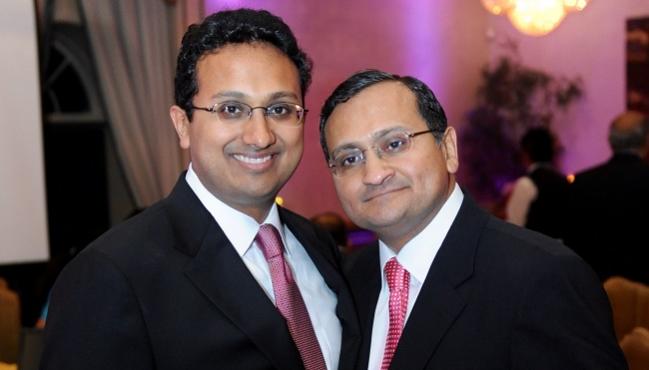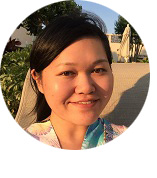When Paths Diverge—and Converge: Manish and Sahil Parikh Make Their Mark as Brothers, Clinicians, and Educators

Any large medical meeting turns a convention center into a hubbub of familiar faces and unfamiliar research. Even amid the bustle, however, it is easy to spot a few visitors who look out of place while weaving between the booths. These 3 small children are not in fact tiny clinicians—they are the offspring of eminent interventional cardiologists who are also brothers, Manish and Sahil Parikh, happy to tag along for a few days.
“I have them come so I can spend time with them and do what I love, which is [educate],” Manish Parikh, MD, of Columbia University Medical Center/NewYork-Presbyterian (New York, NY), told TCTMD in a telephone interview. “They like that they get to see new places.”
While conferences make for unusual family reunions, attending them gives the brothers a chance to join forces academically. Nine years Manish’s junior, Sahil Parikh, MD, of University Hospitals Case Medical Center (Cleveland, OH), serves as director of the interventional cardiology fellowship program and director of the center for research and innovation at University Hospitals Harrington Heart & Vascular Institute. Though both have built individual careers as esteemed clinicians and researchers, the 2 brothers have also been known to enrapture a room together by revealing practical knowledge of the field and their own career paths, most recently at the 2015 CRF Fellows Course in Miami, Florida.
A Lucky Convergence
As for how the Parikhs ended up working professionally in the same niche of medicine, it seems to have been kismet.
“We come from a background without any doctors,” Manish said. Their parents immigrated to the United States from India when Manish was only 5 years old. Landing first in Columbia, Missouri where their father was a graduate student in electrical engineering, they eventually settled in Livingston, New Jersey. A year after, Sahil was born in nearby Orange, New Jersey. A burgeoning interest in electronics and gadgetry kept Manish happy as a weekend employee in the electronics store that his father owned. Sahil too was naturally drawn to engineering as a child.
There was no sign that the 2 brothers might conspire together to become interventional cardiology superstars. Manish studied electrical engineering as an undergraduate before deciding to pursue medicine. It became clear that he valued taking care of patients “with [his] hands,” rebuking surgery for being “long-winded” and not giving him the amount of patient-contact that he desired. During his internal medicine training at NewYork-Presbyterian/Weill Cornell Medical Center (New York, NY), he discovered the emerging specialty of interventional cardiology—a good fit for him because it offered a career of problem solving and taking care of patients longitudinally.
For Sahil, Manish was the influence who unwittingly pointed him toward this career path. As an undergraduate biomedical engineering student at Harvard University, Sahil hosted his older brother, then a resident, while he visited the Boston area for fellowship interviews. Over the course of these interviews, Manish met Elazer Edelman, MD, PhD, of the Harvard-MIT Biomedical Engineering Center. He introduced him to younger brother Sahil, and, serendipitously, a mentorship relationship began.
Sahil, who continues to collaborate with Dr. Edelman, discovered at age 18 his love for biomedical engineering and thought the orthopedic applications of mechanics would be his calling. In an introductory biomechanics course, Sahil learned about hemodynamic flow then realized that there was plenty of room for his beloved mechanics in interventional cardiology. And Manish and Dr. Edelman’s convergence played a large part in the surprising turn in Sahil’s career. “Like a perfect storm of personal and academic influences, it all collided and made me realize I didn’t want to be an orthopedic surgeon after all,” he told TCTMD in a telephone interview.
Sahil earned his MD at Johns Hopkins University School of Medicine (Baltimore, MD), and completed his training at Massachusetts General Hospital—where he served as chief resident—and Brigham and Women’s Hospital (Boston, MA).
Learning to Teach
Manish decided to return to NewYork-Presbyterian for his fellowships in cardiovascular disease and interventional cardiology, and he has stayed in New York ever since. After his training, he found himself in a position to help others along the same career trajectory.
In 1999, interventional cardiology became a board specialty. With the help of George Dangas, MD, PhD; Martin Leon, MD; and many others, Manish started the Interventional Fellows Institute in 2000, which he calls a free “virtual textbook for fellows in training,” an ambitious project that would finally unify the curriculum for the budding field.
Today, the Interventional Fellows Institute, now known as the Fellows in Training (FIT) Core Curriculum and operated by the Society for Cardiovascular Angiography and Interventions, takes a unique multimedia approach to teaching fellows around the world. Lectures, narrated case studies, videos, and other interactive learning tools make it an indispensable resource that has been curated to fit the needs of current fellows. “I learned there is a whole side of education that is no longer standard textbook-style. It is the age of digital learning,” said Manish.
While Manish continues to educate fellows as well as practicing physicians as director of physician education at NewYork Presbyterian Hospital, his clinical focus is on complex coronary intervention, which is different but complementary to Sahil’s clinical focus on complex peripheral intervention and investigation at the interface of biomedical engineering, drug delivery, and stent design. Nonetheless, the brothers are joined by a common passion for education—a commitment that highlights the Parikhs’ dedication to their field. For them, the immense value of teaching is simple math. “It’s about the patient. I can take care of 15,000 patients. But if I train 100 doctors, that’s 100 times 15,000 patients,” said Manish.
Sahil agrees, saying there is nothing more important than spreading knowledge and helping others along the way. Clinicians are frequently discouraged from entering academia, and it is certainly not an easy path. “While academia implies a focus on research, there is enormous value and personal satisfaction derived from being an educator,” he emphasized. “A critical part of our field is our obligation to taking care of patients in addition to training the next generation. The number of people that Manish runs into who were former trainees is “astounding.”
As a fellowship director, Sahil finds it especially important to “educate people about what should be the standard of care.” Teaching fellows is his way of ensuring that clinicians aspire to the same high standards. “You leave an imprint on what is happening in the field in terms of clinical care,” he said.
Keeping It in the Family
All that outreach, however, keeps both Sahil and Manish busy during their free time on weekends and late nights. Having their own children has only made them more aware of the challenges of their chosen career. At meetings, for example, the brothers balance family time with their roles as sought-after speakers and innovators.
Manish notes that a lesson he has learned from every mentor is not to miss out on family time. “If you don’t spend time when [your family] needs it the most, you’ll look back and regret,” he said.
Admittedly, achieving this balance can be difficult. “I particularly admire my women colleagues who are moms. Having a child can change one’s priorities. Their burden is incredible,” Sahil said, adding that he is “particularly sensitive to the challenges in their training.”
Sahil counts himself lucky to have an older brother who continues to guide him in his path. The close relationship between him and Manish offers certain advantages. “It gives us a unique ability to relate to one another and with other people. It’s very advantageous for us to be working together because we know how [the] other works. We can do things without as much explicit communication,” Sahil explained.
And for the record, Sahil related that he feels no competition between him and Manish, especially given the large age difference. Manish “had established himself before I ever finished training,” Sahil said. “There has never been any competition. In fact, what has been so rewarding since I have become an attending has been our opportunity to work together on so many educational programs despite our employment in different centers. To me, it’s pretty amazing that we are in the same space but have such complementary skill sets. It certainly has been a point of pride for us both.”


Comments